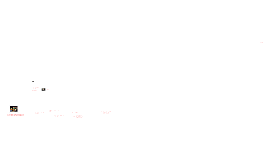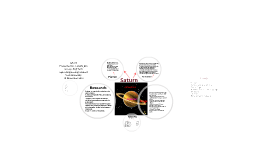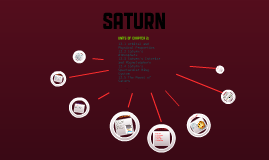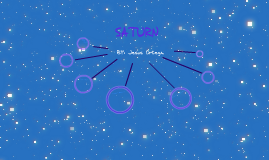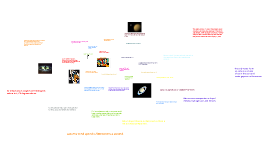Saturn
Transcript: The Evolution of Saturn •The angle and illumination can change depending on Saturn’s positioning with the earth and sun. •The rings are vertical because the north or south pole usually faces the sun •The rings can be anywhere from ten meters to thousands of meters thick •The rings can be either solid, liquid, or gas •Mostly made up of small particles all orbiting around Saturn •Mostly made up of ice •Usually lie along the planets equatorial plane Overview By: Tyler Holloway and Zach Simons Saturn was formed from a solar nebula 4.6 billion years ago when all the other planets in our solar system formed. Saturn’s solar nebula started as a huge cloud of gas and dust, which was disturbed. The cloud got compressed down into a proto-star surrounded by a flat metal disk. A proto-star is an early stage in a stars life before nucleosynthesis. The inner part of the metal disk turned into terrestrial planets but the outside of the ring turned into planetesimals, which crashed into each other and turned into the outer planets we know today. We think that a moon about 300 km in diameter was torn apart and turned into Saturn’s rings. ·Saturn has atmospheric wind patterns ·Computer-enhanced images show bands of storm systems ·These storms are caused by the rapid rotation ·There is a white spot caused by ice crystallization and this has many of the same weather patterns as Jupiter’s Great Red Spot. ·The lightning on Saturn is millions of times stronger than on Earth. Weather http://clccharter.org/kurt1/Galaxy%20Project/Saturncreation.html Chaisson, Eric, and Steve Mcmillan. Astronomy Today. San Francisco, California: Jim Smith, 2008. Print. Bibliography Compositon of Saturn The Roche Limit Interesting Facts! •Saturn is the second largest planet of the solar system in mass and size • It is the sixth planet in distance from the Sun • In the night sky Saturn is easily visible to the unaided eye as a non-twinkling point of light • When viewed through even a small telescope, the planet, encircled by its magnificent rings, is arguably the most gorgeous object in the solar system • Saturn is the second in apparent brightness behind Jupiter •Saturn has many moons •Saturn is 95 times the mass of earth •Saturn is less dense than water Titan is the most famous out of all the moons One of the only moons with an atmosphere Atmosphere is thicker and more dense than Earth’s Larger than mercury, and half the size of earth Big enough to be its own planet, but it can’t because it’s in orbit of Saturn Saturn's Rings 1.Saturn is the least dense planet in the Solar System 2.Saturn is a flattened ball 3.The first astronomers thought the rings were moons 4.Saturn has only been visited 4 times by spacecraft 5.Saturn has 60 moons 6.How long is a day on Saturn is a mystery 7.Saturn’s rings could be old, or they could be young 8.Sometimes the rings disappear 9.You can see Saturn with your own eye 10.There could be life near Saturn Saturn The Universe. History Channel, 2007. Film. •Mostly hydrogen, helium, methane, and Ammonia •Has a lot of the same properties as Jupiter •Helium started as the atmosphere of Saturn then sunk in to its core overtime •Lacks a solid surface •Has very weak gravity •The clouds are thick, so from Earth we rarely see multiple colors even though there are many colors throughout the layers. http://arxiv.org/abs/0912.3017 Titan






